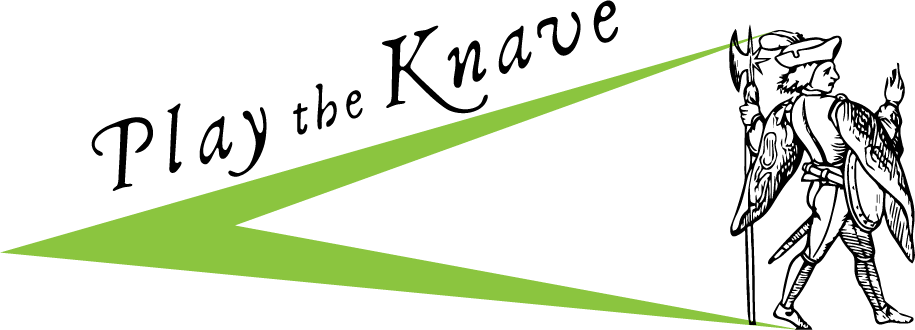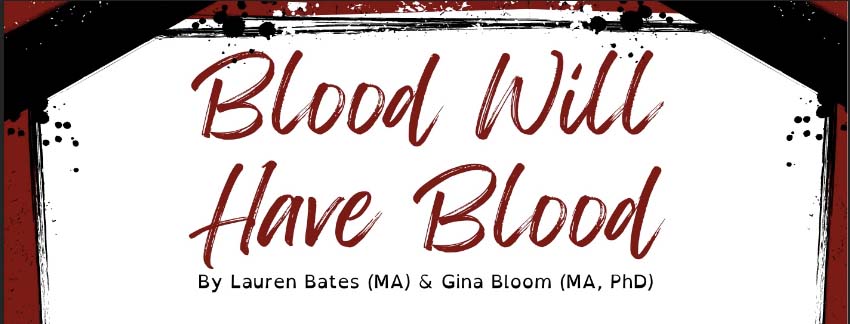The teaching materials that follow are part of a program called “Blood Will Have Blood” that was developed by Lauren Bates, a high school teacher, education consultant, and theater professional in Cape Town, South Africa, and Gina Bloom, a professor of English at the University of California, Davis. Though designed for high school learners, the program has, to date, been used in dozens of middle school, high school, and college classrooms.
Focused on four of the most commonly taught Shakespeare plays—Hamlet, Macbeth, Othello, and Romeo and Juliet—the lessons included in “Blood Will Have Blood” integrate Play the Knave with theater-based activities and discussion prompts in order to teach critical reading, thinking, writing, and listening skills. Alongside the lessons are optional creative and critical writing assignments that reinforce lesson concepts and help learners explore links between Shakespeare’s plays and learners’ own lives–particularly around issues of violence.
“Blood Will Have Blood” centers learners’ own experiences with violence—whether in their own lives, in their communities, or in the media they consume—as a foundation for understanding the plots, characters, and themes of Shakespeare’s plays. Each lesson deals with a different form of violence that was as prevalent in Shakespeare’s time as in our own. Beyond simply analyzing this violence, “Blood Will Have Blood” asks learners to think about how violence could be prevented in the plays and in learners’ own worlds. The program aims to support social and emotional learning, helping learners discover and refine strategies for dealing with conflict without resorting to violence.
Each downloadable lesson bundle includes all the materials needed to teach the lessons:
- Lesson Plans: We provide highly detailed lesson plans for teachers to follow. In some cases, we provide alternative lesson options in case of technical challenges or time constraints.
- Handouts: In addition to the script of the scene being discussed, we provide student handouts to guide group and individual discussion. Each student handout ends with a short reflective writing task to reinforce lesson concepts and to help learners apply their own knowledge of or experience with violence to understand the characters and conflicts in the play.
- Game Files: The game files for each lesson will need to be saved to the computer you’re using to run Play the Knave’s software. Instructions on how to use the game files are included in each lesson plan. To open these files, you will need to be using the game’s software or using our free scriptwriting software, Mekanimator Scriptmaker.
- Assignments: These visually compelling assignments prompt students to write in a range of genres, most of which correspond directly with writing requirements in the English curriculum of most schools.
- Learning outcomes: You’ll find a chart showing the learning outcomes for each lesson bundle. For teachers in the U.S., the outcomes are correlated with the Common Core Learning Standards.
We strongly encourage teachers who plan to use Play the Knave in their classrooms to read over the document “Advice and Best Practices.”
Teachers who wish to teach lessons from this program but who do not have access to the hardware required to run Play the Knave are invited to visit https://playtheknave.org to inquire about our equipment loan program, which is available at no cost to teachers in the U.S. and South Africa.
Lesson Bundles

Advice and Best Practices
➔ Set up the Play the Knave game and try it out yourself at least one day before the lesson to make sure you know how to navigate the menu and set up your classroom. See the Player’s Handbook and set-up guides included with the Knave Kit.
➔ Mark the boundaries of your classroom “stage” (that is, the places where the game’s motion capture camera can see the players). An easy way to do this is with the “Free Play” option on the game menu. Choose an avatar and move around your play space to figure out where the avatar disappears and/or acts erratically. Place physical objects, such as chairs, desks, books, or floor tape, to indicate the boundaries for the play space.
➔ Show the game to learners before you begin the lesson so that they understand how to get the most out of the platform. If you are short on time and cannot do one or several of the game’s warm up activities (including “warm up” and “theater games”) discuss with learners:
- Timing of lines: the karaoke timing cannot be changed, so learners need to adjust their speech timing to the lines. If the lines feel “too slow,” learners need to slow down their speech or find a productive way to use the pauses/silence.
- Avatar “glitchiness”: to get a smooth performance with the avatars, players must face the Kinect camera directly and try not to cross their hands or legs in front of their bodies.
- Play space: performers need to be aware of the borders of the play space; their avatar will disappear from the screen when they move beyond those borders. A player’s avatar will also disappear if another player steps between them and the Kinect camera.
➔ Before staging a scene for the first time, it is very helpful to rehearse the scene with avatar movement (entrances, exits, blocking). Use the “Free Play” option from the Play the Knave menu As the teacher paraphrases what the characters are saying in each line, the class can help the players decide on their movements. This is especially helpful so players learn how to share the stage space without standing in front of each other.
➔ If using the “perform your own script” option with multiple players in a scene, take note of the order of the players as they select their avatars. When players come to the white line to get their avatars at the start of the scene, they will need to come up in that same order to get the right avatars. Make sure that after they get their avatars, they step back to make space for their scene partner(s) to come forward for their avatar(s).
➔ Choosing which avatars, soundtrack, and stage to use for a performance can present important moments for learning. If the lesson does not already specify these options, decide in advance how these choices will be made (students choose and explain their rationale for choices, or you choose). If students are choosing, have them write down their choices before groups come up to play. Otherwise, you will waste valuable class time while learners scan the options and make their choices. Students can see the options on our website: https://www.playtheknave.org/about.html.
➔ The game records each performance so that each group will, just by playing, create an animated film of their performance. These will be saved automatically to the Videos folder on your computer. (If using our Knave Kit, the videos folder will be on the desktop.) Consider ways to use these recordings during discussion and/or make them available to learners while they are working on tasks.
➔ For students who may struggle to read the lines aloud and move an avatar at the same time, you can divide acting responsibility for the character: have one student be the “body actor”, responsible for moving the avatar, and another student be the “voice actor,” reading the lines while standing or sitting off-stage behind the body actor.
➔ Unless you devote extra class time to the lesson or have a small number of students in your class, not all learners or groups of learners will have a chance to perform. Do try to call on different students/groups whenever you can, but don’t worry too much about the fact that many students will do the work but not perform. As it is, not all students want a turn and, fortunately, our research has shown that students learn just as much, if not more, from watching as they do from performing.

